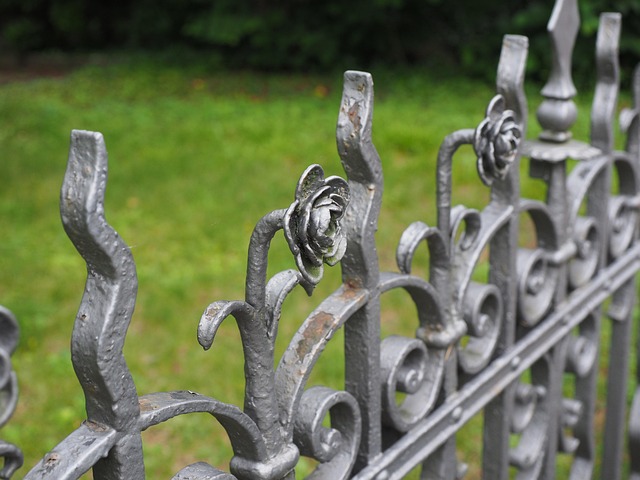New Bedford, Massachusetts’ diverse seasons present unique challenges for fence maintenance. From the harsh winter cold to warm, humid summers, proper care is essential to preserve your property’s fencing. This guide offers comprehensive recommendations tailored to New Bedford’s climate, covering cleaning, repainting, metal care, pruning, and winterizing to ensure your fences remain sturdy and attractive year-round.
- Understanding New Bedford's Climate for Fencing
- Seasonal Cleaning: Preparing Your Fence for Spring
- Repainting and Sealing: Protecting Wood Fences
- Metal Fence Maintenance: Rust Prevention Tips
- Pruning and Repair: Keeping Fences Healthy
- Winterizing: Preparing Fences for Cold Weather
Understanding New Bedford's Climate for Fencing
New Bedford, Massachusetts experiences all four seasons, each presenting unique challenges and requirements for fence maintenance. The climate plays a significant role in determining the longevity and performance of fences. In winter, cold temperatures and frequent snowstorms can take a toll on wooden fences, causing them to rot or crack. Snow accumulation can also lead to potential fence damage if not managed properly. During spring and summer, the region’s humidity levels increase, which can contribute to mold and mildew growth on treated wood. Moreover, hot summers bring high winds that can loosen posts and panels, necessitating regular inspections and repairs. Understanding these seasonal variations is crucial for homeowners in New Bedford to implement effective fence maintenance strategies.
Seasonal Cleaning: Preparing Your Fence for Spring
As winter transitions into spring, it’s time to give your New Bedford fence a fresh start. Seasonal cleaning is an essential part of fence maintenance that ensures your fence looks its best throughout the year. Begin by removing any debris, leaves, or snow accumulation from the fence panels and posts. Use a soft-bristled brush to gently scrub away dirt and grime, restoring the fence’s original color and texture.
This is also the perfect time to check for any damage caused by the winter weather. Inspect the fence for loose or missing boards, rusted hardware, or rot. Addressing these issues early will prevent further deterioration and ensure a longer-lasting fence. Make necessary repairs or replacements before the busy spring and summer seasons set in, allowing you to fully enjoy your well-maintained outdoor space.
Repainting and Sealing: Protecting Wood Fences
Repainting and sealing your wood fence is an essential step in maintaining its beauty and longevity, especially in New Bedford’s changing seasons. The harsh winters and hot summers can take a toll on outdoor structures, making it crucial to prepare and protect your fence accordingly. Repainting provides a fresh look while also serving as a barrier against the elements. It fills in any gaps or cracks, preventing water from seeping in and causing rot or decay.
When choosing a paint, opt for a high-quality exterior wood stain or paint formulated to withstand outdoor conditions. This will create a protective coat that shields the fence from UV rays, rain, snow, and other weather-related damage. Regular repainting, typically every 2-3 years, ensures your fence remains in excellent condition, preserving its natural beauty and value for years to come.
Metal Fence Maintenance: Rust Prevention Tips
Metal fences are a popular choice for many New Bedford properties due to their durability and aesthetic appeal. However, proper maintenance is crucial to ensure they remain in top condition, especially against rust, which can weaken and damage the fence over time. Regular cleaning is essential; use a soft brush or cloth to remove any dirt, debris, or moss buildup.
Apply a fresh coat of paint or primer annually to create a protective barrier against moisture and corrosion. Ensure the metal is dry before painting to prevent peeling. Additionally, consider using rust-preventative coatings or treatments designed for outdoor metal surfaces. Regular inspection for signs of rust or damage, and prompt repair, will help extend the life of your metal fence and maintain its structural integrity.
Pruning and Repair: Keeping Fences Healthy
Regular pruning is essential for maintaining a healthy fence, removing any dead or diseased branches that could weaken its structure. For New Bedford homeowners, this typically involves trimming back overhanging foliage from neighboring trees and shrubs to prevent them from encroaching on the fence and causing damage. It’s also crucial to address any rotting or broken wooden components promptly, replacing or repairing them before they compromise the overall stability of the fence.
During the winter months, when many plants are dormant, this maintenance becomes less intensive but still vital. Pruning allows sunlight and air to reach all parts of the fence, encouraging new growth in the spring. Additionally, checking for signs of pest infestation or further structural damage is a good practice at this time of year, ensuring that any issues are caught early and treated effectively.
Winterizing: Preparing Fences for Cold Weather
Winterizing your fence is an essential step to protect it from the harsh winter conditions in New Bedford, Massachusetts. Before the first freeze, inspect your fence for any damage or loose components and make necessary repairs. This includes tightening hinges, replacing broken pickets, and securing any loose boards.
To prepare for cold weather, consider applying a protective coat of waterproof sealant or paint to wooden fences. This barrier helps shield the wood from moisture, preventing rot and decay. Additionally, clean and clear any debris accumulated on the fence throughout the fall season. Removing leaves, twigs, and other organic matter ensures that snow and ice don’t accumulate, reducing the risk of structural damage during winter storms.
